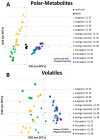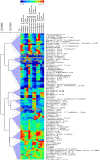Search for transcriptional and metabolic markers of grape pre-ripening and ripening and insights into specific aroma development in three Portuguese cultivars
- PMID: 23565246
- PMCID: PMC3614522
- DOI: 10.1371/journal.pone.0060422
Search for transcriptional and metabolic markers of grape pre-ripening and ripening and insights into specific aroma development in three Portuguese cultivars
Abstract
Background: Grapes (Vitis species) are economically the most important fruit crop worldwide. However, the complexity of molecular and biochemical events that lead to ripening of berries as well as how aroma is developed are not fully understood.
Methodology/principal findings: In an attempt to identify the common mechanisms associated with the onset of ripening independently of the cultivar, grapes of Portuguese elite cultivars, Trincadeira, Aragonês, and Touriga Nacional, were studied. The mRNA expression profiles corresponding to veraison (EL35) and mature berries (EL36) were compared. Across the three varieties, 9,8% (2255) probesets corresponding to 1915 unigenes were robustly differentially expressed at EL 36 compared to EL 35. Eleven functional categories were represented in this differential gene set. Information on gene expression related to primary and secondary metabolism was verified by RT-qPCR analysis of selected candidate genes at four developmental stages (EL32, EL35, EL36 and EL 38). Gene expression data were integrated with metabolic profiling data from GC-EI-TOF/MS and headspace GC-EI-MS platforms.
Conclusions/significance: Putative molecular and metabolic markers of grape pre-ripening and ripening related to primary and secondary metabolism were established and revealed a substantial developmental reprogramming of cellular metabolism. Altogether the results provide valuable new information on the main metabolic events leading to grape ripening. Furthermore, we provide first hints about how the development of a cultivar specific aroma is controlled at transcriptional level.
Conflict of interest statement
Figures









References
-
- Yadav M, Jain S, Bhardwaj A, Nagpal R, Puniya M, et al. (2009) Biological and medicinal properties of grapes and their bioactive constituents: an update. J Med Food 12: 473–484. - PubMed
-
- Coombe B, McCarthy M (2000) Dynamics of grape berry growth and physiology of ripening. Australian Journal of Grape and Wine Research 6: 131–135.
-
- Coombe B (1995) Growth Stages of the Grapevine: Adoption of a system for identifying grapevine growth stages. Australian Journal of Grape and Wine Research 1: 104–110.
-
- Terrier N, Glissant D, Grimplet J, Barrieu F, Abbal P, et al. (2005) Isogene specific oligo arrays reveal multifaceted changes in gene expression during grape berry (Vitis vinifera L.) development. Planta 222: 832–847. - PubMed
Publication types
MeSH terms
LinkOut - more resources
Full Text Sources
Other Literature Sources
Molecular Biology Databases
Miscellaneous

